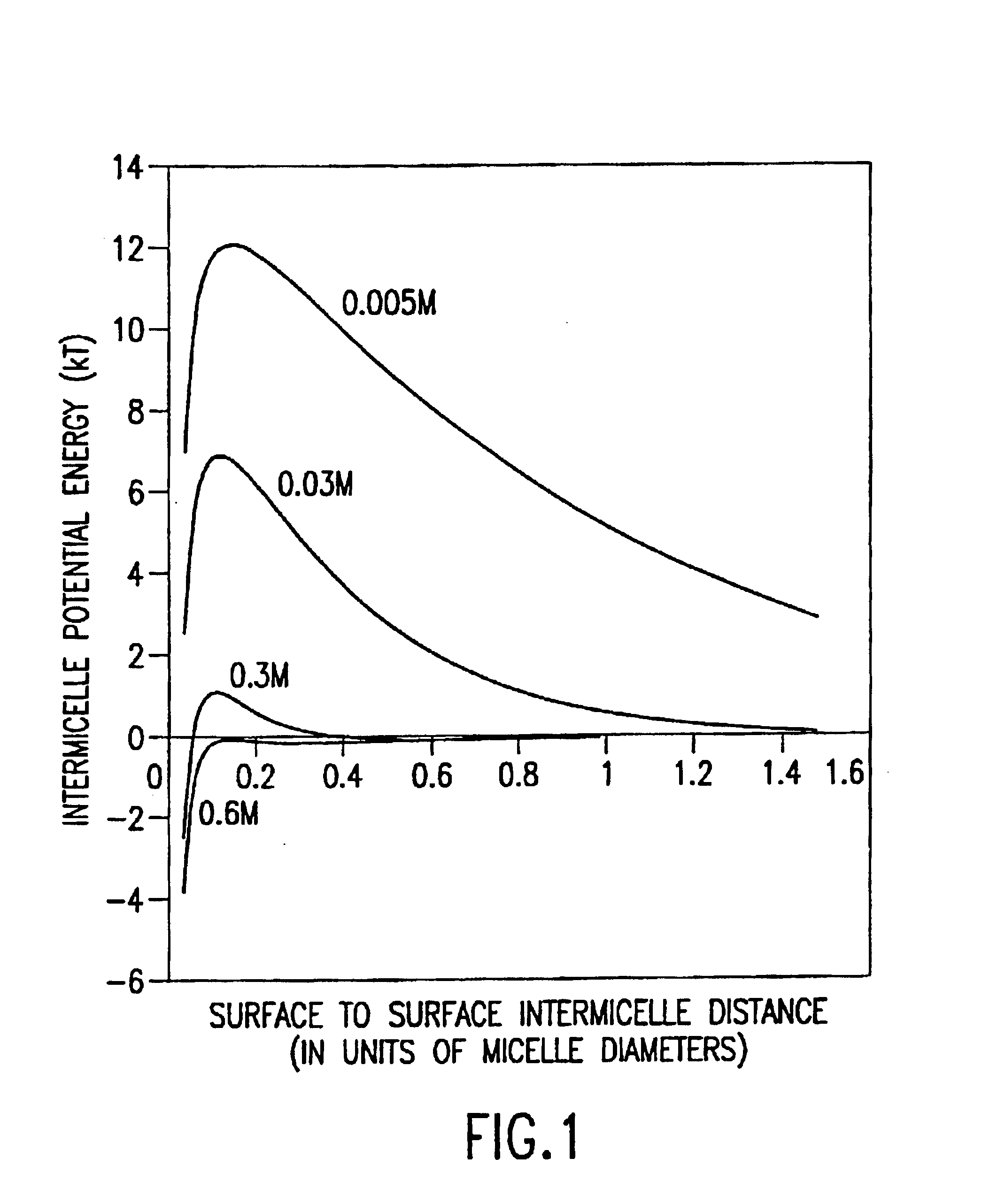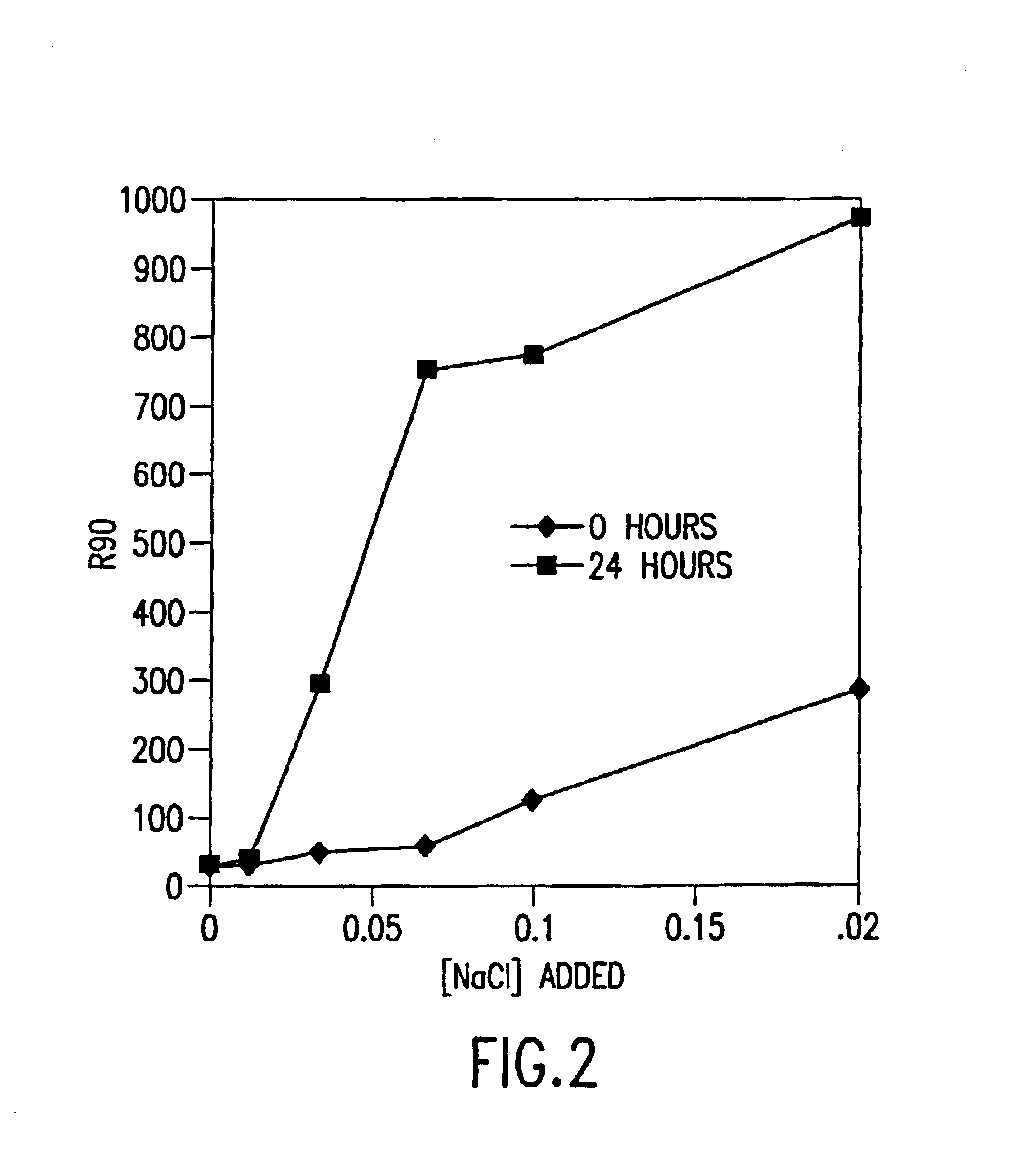Micelles
a technology of micelles and micelles, applied in the field of micelles, can solve the problems of limited control of the micelle size of a drug delivered in a pharmaceutical formulation, and the limitation of the control of the rate of delivery of the drug to the site of action,
- Summary
- Abstract
- Description
- Claims
- Application Information
AI Technical Summary
Benefits of technology
Problems solved by technology
Method used
Image
Examples
example 1
[0070]E5564 is a lipopolysaccharide analog comprising two sugar moieties and four long chain fatty acid moieties and has a molecular weight of about 1,401. Methods for preparing E5564 are described in U.S. Pat. Nos. 5,530,113, 5,681,824, 5,750,664, 5,935,938, and 6,184,366, and WO 96 / 39411, the disclosures of which are incorporated by reference herein in their entirety. E5564 drug formulations with varying micelle hydrodynamic diameters, achieved by control of the pH and concentration of counter ions (e.g., sodium), were produced as follows.
[0071]E5564 was dissolved in an NaOH solution for 60 minutes. The pH of the NaOH solution can be varied from 9 to 13 by varying the NaOH and NaCl concentrations, such that the concentration of Na+ in each solution was kept constant at 0.01 M. The concentration of Na+ in the solution can be in the range from about 0 to 0.6 M, preferably from about 0.001 M to about 0.6 M. The E5564 / NaOH solution was then combined with a phosphate buffer solution to...
example 2
[0073]Micelles of E5564 having a hydrodynamic diameter of 7 nm to 9 nm (Table 1) prepared as described above were lyophilized. After lyophilization the micelles were reconstituted with water diluted in an aqueous dextrose solution (Table 2). The micelle hydrodynamic diameter of E5564 in the reconstituted solutions remained at 7 nm to 9 nm in the reconstituted physiologically acceptable solutions under various conditions. The E5564 micelle hydrodynamic diameter was stable when reconstituted in water for 24 hours at 25° C. 5564 micelle hydrodynamic diameter was unchanged after dextrose solution maintained at pH 7.4 and storage for 24 hours at 25° C. or 72 hours at 2 to 8° C. (Table 2). The E5564 micelle hydrodynamic diameter was stable as a drug protect stored in a lyophilized state at 25° C. under 60% relative humidity, or under refrigeration (Table 3). Further, the E5564 micelle hydrodynamic diameter, in micelles prepared according to the methods of the present invention, was stable...
example 3
[0079]The micelle hydrodynamic diameter formed utilizing the methods of the invention was destabilized by added salt. FIG. 2 shows the increase in micelle hydrodynamic diameter (as measured by an increase in light scattering intensity, R90) with added NaCl. The E5564 micelle hydrodynamic diameter remained unchanged for 24 hours after addition of 0.01 M NaCl. Changes in micelle hydrodynamic diameter were observed after 24 hours with the addition of 0.03 M NaCl or greater. However, up to 0.07 M NaCl was added with no immediately appreciable change in micelle hydrodynamic diameter. Therefore, higher salt concentrations can be added if the required stability time is less than 24 hours.
PUM
| Property | Measurement | Unit |
|---|---|---|
| hydrodynamic diameter | aaaaa | aaaaa |
| hydrodynamic diameter | aaaaa | aaaaa |
| hydrodynamic diameter | aaaaa | aaaaa |
Abstract
Description
Claims
Application Information
 Login to View More
Login to View More - R&D
- Intellectual Property
- Life Sciences
- Materials
- Tech Scout
- Unparalleled Data Quality
- Higher Quality Content
- 60% Fewer Hallucinations
Browse by: Latest US Patents, China's latest patents, Technical Efficacy Thesaurus, Application Domain, Technology Topic, Popular Technical Reports.
© 2025 PatSnap. All rights reserved.Legal|Privacy policy|Modern Slavery Act Transparency Statement|Sitemap|About US| Contact US: help@patsnap.com



